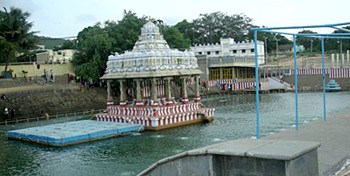 Generally old temples of South India, big and small, have a tank (water tank are storage containers for water, these tanks are usually storing water for human consumption) mostly square or rectangular in shape attached to them. Known as pushkarini, they are sacred in nature and are used as a source of water-supply for the temples. Water drawn from these tanks is used for the holy bath (abhishekam) of the idols enshrined in the temples and the float festival (teppam) of the deities during certain specified times of the year takes place here. The waters of some of these pushkarinis are believed to have certain specific curative properties and pilgrims have a dip in these waters to cure their diseases and also for cleansing themselves before going into the temple.
Generally old temples of South India, big and small, have a tank (water tank are storage containers for water, these tanks are usually storing water for human consumption) mostly square or rectangular in shape attached to them. Known as pushkarini, they are sacred in nature and are used as a source of water-supply for the temples. Water drawn from these tanks is used for the holy bath (abhishekam) of the idols enshrined in the temples and the float festival (teppam) of the deities during certain specified times of the year takes place here. The waters of some of these pushkarinis are believed to have certain specific curative properties and pilgrims have a dip in these waters to cure their diseases and also for cleansing themselves before going into the temple.
These temples tanks provided with many inlets to allow excess rainwater to enter the tank. Thus, during the monsoons, these tanks would be full and in summer too would retain a certain amount of water which could be used by the temple and those living in the premises attached to these shrines. The tanks also served to recharge the water of the wells in the vicinity during the dry seasons and water scarcity was a rather rare occurrence in the ancient and medieval times. It is rather unfortunate that in the overcrowded towns and cities today, these inlets have been blocked by indiscriminate construction activity and thus many of these temple tanks are totally dry and some are even used as dumping grounds for waste matter.
Some of these pushkarinis deserve special mention either on account of their shape, size or religious sanctity. Probably the largest temple tank of Tamil Nadu and perhaps of all of South India is the one attached to the Rajagopala Svami temple in Mannargudi. It is known as Haridra Nadi and also as Gopala Samudram. A proverb which is often quoted with regard to Mannargudi is kovil paadhi, kulam paadhi indicating that, this tank is as big as the temple. The very famous Kamalalaya tank at Tiruvarur (Tamil Nadu), eulogized in the songs (kirthanas) of Muthusvami Dikshitar, is also very huge.
The Svami Pushkarini, which is the tank attached to the world-famous Sri Venkateshwara temple at Tirumala (Andhra Pradesh) is one of the best known with thousands of devotees bathing in it before going into the temple. The grand spectacle of the float festival of this temple draws thousands of onlookers every year to this sacred shrine.
Tanks of peculiar shapes are also known in South India. One of these is in the Pundarikaksha temple at Tiruvellarai (Tamil Nadu), where the tank is in a unique svastika shape. This svastika tank, which belongs to the Pallava age of the 8th-9th centuries A.D. is mentioned in one of the inscriptions, as tnaarpidujju perunkinaru.
There are also some large temples, which have more than one tank, and some are seen inside the enclosure of the temple while some may be found immediately outside the temple campus. The kings and chieftains of yore considered it an act of great merit to construct these temple tanks and innumerable inscriptions have been discovered across South India which mention the names of the donors and also the date of construction





















